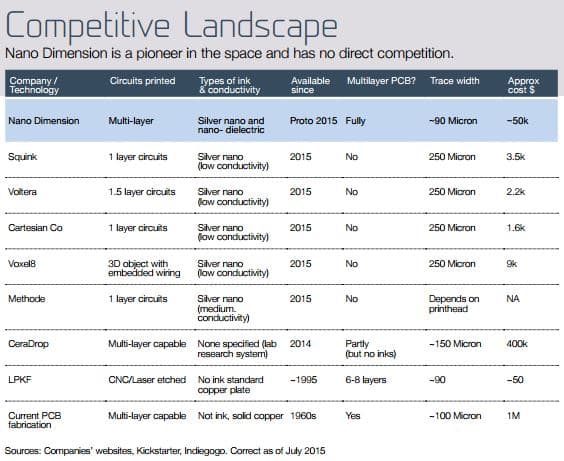Nano Dimension: 3D Printing Electronics with Nano Ink
Table of contents
Table of contents

3D Printing just keeps getting pounded, with the “Nanalyze 3D Printing Stocks” motif down -35% since we first created it in June. While the 3D printing theme has fallen out of favor with investors, the potential of this disruptive technology hasn’t changed a bit. We’ve talked before about “printed electronics“, and how the ability to print circuits onto a circuit board can’t really be considered “3D”. The only exception might be Voxel8’s printer which is actually capable of embedding electronics in 3D objects using conductive silver ink. However just last week, a company called Nano Dimension entered the “3D printed electronics” space with the announcement of their DragonFly 2020 3D printer which uses nano-inks to print multilayer printed circuit boards.
About Nano Dimension
Founded in 2012, this 35-employee Israeli company is focused on developing a 3D printer that can produce printed circuit boards along with nanotechnology-based inks. With a current market cap of $49 million, Nano Dimension is publicly traded on the Tel Aviv Stock Exchange (TLV:NNDM) and also as an ADR on the over-the-counter (OTC) market under the symbol NNDMY. The Company has taken in around $15 million in funding to date and just last week, revealed their DragonFly 2020 3D Printer which they claim is the world’s first desktop-sized 3D printer that can produce multilayer printed circuit boards.
The world “multilayer” is key here, because per the below competitive analysis, many companies can print circuit boards but only Nano Dimension can print “multilayer” circuit boards using their highly conductive nano-inks:
The ability to print using multiple layers may also lend some credibility to the “3D Printing” label being ascribed to their printer offering. In addition to their newly announced printer, the Company’s highly conductive silver nano-inks are being developed through an exclusive technology license with the Hebrew University. These are also available to be sold separately for sectors such as RFID, solar, and OLED and have the potential to be “a significant immediate revenue stream”. Both their printing process and their nano-inks are protected by a growing intellectual property portfolio.
In Q3 2015, Nano Dimension announced their first sale of five DragonFly 3D printers that will be supplied in the second half of 2016 along with 5kg of nanosilver ink to an Indian company called Vigilante Environmental Solutions. An additional sale of several printers to ALA Software Solutions was also announced with total revenues from both of these contracts expected to total around $430 thousand. At the end of Q3 2015, Nano Dimension had $8.9 million in cash on hand. In that same quarter, they burnt through about $1.3 million.
Conclusion
Foreign investors who wish to invest in Nano Dimension can buy the company on the OTC market, however, the issue seems very illiquid. Nano Dimension has filed recently to list their shares on NASADAQ as an ADR offering so it may be best to wait until that takes place prior to investing.
Sign up to our newsletter to get more of our great research delivered straight to your inbox!
Nanalyze Weekly includes useful insights written by our team of underpaid MBAs, research on new disruptive technology stocks flying under the radar, and summaries of our recent research. Always 100% free.

















